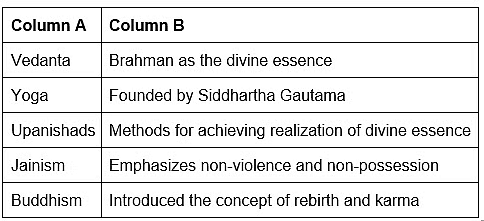Chapter 6 The Beginnings of Indian Civilisation Worksheet Solutions
November 5, 2024Chapter 7 India’s Cultural Roots Worksheet Solutions
November 5, 2024Multiple Choice Questions (MCQs)
Q1: What does the word “Veda” mean?
a) Wisdom
b) Knowledge
c) Power
d) Strength
Q2: Who composed the Vedic hymns?
a) Kings
b) Rulers
c) Seers and Sages
d) Warriors
Q3: Which Veda is considered the most ancient?
a) Yajur Veda
b) Sama Veda
c) Atharva Veda
d) Rig Veda
Q4: What is the term for the collective gatherings or assemblies mentioned in the Vedas?
a) Sabha and Samiti
b) Yagna and Puja
c) Panchayat and Sabha
d) Rajya and Sabha
Q5: Which school of thought believed in the concept of rebirth and karma?
a) Vedanta
b) Yoga
c) Charvaka
d) Upanishads
Fill in the Blanks
Q1: The Vedas consist of thousands of hymns in the form of _________ and songs.
Q2: Early Vedic society was organized in different _________ or ‘clans’.
Q3: The Upanishads introduced the concept of _________, the divine essence that resides in every being.
Q4: Jainism includes the principle of _________, which means ‘non-possession’.
Q5: The Vedas gave rise to several schools of thought, including _________ and Yoga.
True or False
Q1: The Vedas were composed in written form.
Q2: Siddhartha Gautama founded Jainism.
Q3: The term ‘Jina’ in Jainism means ‘conqueror’.
Q4: Buddhism and Jainism accepted the authority of the Vedas.
Q5: Tribal belief systems have had no interaction with Hinduism.
Match the Following


